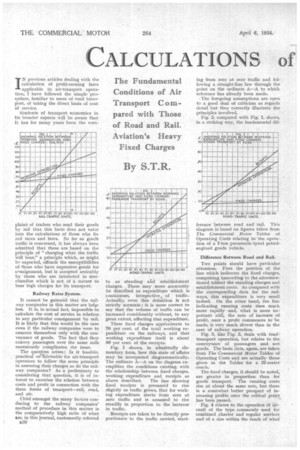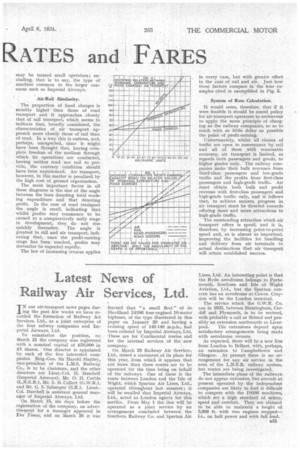CALCULATIONS
Page 48

Page 49

If you've noticed an error in this article please click here to report it so we can fix it.
RATES and FA
ES
The Fundamental Conditions of Air Transport C o m pared with Those
of R. .d and ail. Aviation's Heavy
Fixed Charges
y S.T.
IN" previous articles dealing with the calculation of profit-earning fares applicable to air-transport opera. t on,. I have followed the simple pro• cedure, familiar to users of road transPort, of taking the direct basis of cost of service.
Students of transport economics in its broader aspects will be aware that it has for many years been the corn plaint of traders who send their goods by rail that this basis does not enter into the calculations of those who fix rail rates and fares. So far as goods traffic is concerned, it has always been admitted that these are based on the principle of "charging what the traffic will bear," a principle which, as might be expected, offends the susceptibilities of those who have expensive goods for consignment, but is accepted amicably by those who are interested in merchandise which is not Of a nature to bear high charges for its transport.
Railway Rates System.
It cannot be gainsaid that the railway companies in this matter are helpless. It is, in actual fact, impossible to "calculate the cost of service in relation to any particular consignment by rail. It is likely that this would be the case even if the railway companies were to concern themselves only with the conveyance of goods. The fact that they convey passengers over the same rails enormously complicates the issue.
The question arises: Is it feasible, practical oil.^trivisable for air-transport operators to follow the same principle in assessing their charges as do the railway compzinies? As a preliminary to considering that question, it is of interest to examine the relation betwee;i costs and profit in connection with the three forms of transport—rail, road, and air.
Chief amongst the many factors conducing to the railway companies' method of procedure in this matter is the comparatively high ratio of what are, in this journal, customarily referred B30
to as standing al'id establishment charges. These may more accurately be described as expenditure which is continuous, irrespective, of traffic. Actually, even this definition is not strictly accurate; it is more correct to say that the volume of traffic can be increased considerably without, to any great extent, affecting that expenditure.
These fixed charges approximate to 70 per cent, of the total working expenditure on the railways, and that working expenditure itself is about 80 per cent, of the receipts.
Fig. 1 shows, in admittedly elementary form, how this state of affairs may be interpreted diagrammatically. The ordinate A—A on the diagram exemplifies the conditions existing, with the relationship between fixed charges, working expenditure and receipts as
above described. The line showing fixed receipts is presumed to rise slightly as traffic grows, that for working expenditure starts from zero at zero traffic and is assumed to rise steadily in proportion to the increase in traffic.
Receipts are taken to be directly proportionate to the traffic carried, start
ing from zero at zero traffic and following a straight-line law through the point on the ordinate A—A to which reference has already been made.
The foregoing assumptions are open to a good deal of criticism as regards detail but they correctly illustrate the principles involved.
Fig. 2, compared with Fig. 1, shows, in a striking way, the fundamental dif
ference between road and rail. This diagram is• based on figures taken from The Commercial Motor Tables• of Operating Costs relating to the operation of a 7-ton pneumatic-tyred petrolengined goods vehicle.
Difference Between Road and Rail.
Two points should have particular attention. First the position of the line which indicates the fixed charges, comprising (according to the aforementioned tables) the standing charges and establishment costs. As compared with the corresponding data for the railways, this expenditure is very small indeed. On the other hand, the line indicating running costs rises much more rapidly and, what is more important still, the rate of increase of profit, once a profit commences to be made, is very much slower than in the case of railway operation.
Fig. 3, like Fig. 2, deals with roadtransport operation, but relates to the conveyance of passengers and not goods. The basic data, again, are taken from The Commercial Motor Tables of Operating Costs and are actually those given in the Tables for a 32-seater coach.
The fixed charges, it should be noted, are greater in "proportion than for goods transport. The • running costs rise at about the same rate, but there is a somewhat better prospect • of increasing profits once the critical point has been passed.
Fig. 4 relates to the operation of aircraft of the type commonly used for combined charter and regular services and of a size within the reach of what may be termed small operators ; excluding, that is to say, the type of machine common to the larger concerns such as Imperial Airways.
Air-Rail Similarity.
The proportion of fixed charges is notably higher than those of road transport and it approaches closely that of rail transport, which seems to indicate that, broadly considered, the characteristics of air transport approach more closely those of rail than of road. In a way this is curious, and, perhaps, unexpected, since it might have been thought that, having complete freedom of the medium through which its operations are conducted, having neither road nor rail to provide, the contrary condition should have been experienced. Air transport, however, in this matter is penalized by the high cost of ground organization.
The most important factor in all these diagrams is the size of the angle between the lines denoting total working expenditure and that denoting profit. In the case of road transport the angle is small, indicating that whilst profits may commence to be earned at a comparatively early stage in development, they do not rise quickly thereafter. The angle is greatest in rail and air transport, indicating that, once the profit-earning stage has been reached, profits may thereafter be expected rapidly.
The law of increasing returns applies in every case, but with greater effect in the case of rail and air. Just how these factors compare in the four examples cited is exemplified in Fig. 5.
System of Rate Calculation.
It would seem, therefore, that if it were feasible it should be sound policy for air-transport operators to endeavour to apply the same principle of charging as the railway companies, so as to reach with as little delay as possible the point of profit-earning.
Unfortunately, whilst all classes of traffic are open to conveyance by rail and all of them with reasonable economy, air transport is limited, as regards both passengers and goods, to higher grades only. The railway companies make their bulk revenues from third-class passengers and low-grade traffic and the profits from first-class passengers and high-grade traffic. Air must obtain both bulk and profit revenue with first-class passengers and high-grade traffic only, and it follows that, to achieve success, progress in air transport must be directed towards offering more and more attractions to high-grade traffic.
The outstanding attraction which air transport offers is speed, and it is, thereford, by increasing point-to-point speed and, as is almost as important, improving the facilities for handling and deliVery from air terminals to actual destinations that air transport will attain established success.




































































































